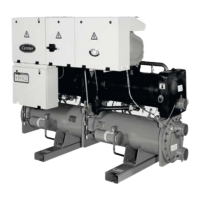6
Consult Carrier Service for this type of test. Carrier mentions here
only the principle of a test without removing the pressure switch:
- Verify and and record the setpoints of pressure
switches and relief devices (valves and possible
rupture discs)
- Be ready to switch-off the main disconnect switch of
the power supply if the pressure switch does not
trigger (avoid over-pressure or excess gas in case of
valves on the high-pressure side with the recovery
condensers)
- Connect a calibrated pressure gauge (the values
displayed on the user interface may be inaccurate in
an instant reading because of the scanning delay
applied in the control)
- Neutralise the HP soft value
- Cut the condenser water ow
- Check the cut-off value
- Reactivate HP soft value
- Reactivate manually HP switch.
CAUTION: If the test leads to replacing the pressure switch, it
is necessary to recover the refrigerant charge, these pressure
switches are not installed on automatic valves (Schraeder type).
At least once a year thoroughly inspect the protection devices
(valves). If the machine operates in a corrosive environment,
inspect the protection devices more frequently.
Regularly carry out leak tests and immediately repair any leaks.
Ensure regularly that the vibration levels remain acceptable
and close to those at the initial unit start-up.
Before opening a refrigerant circuit, purge and consult the
pressure gauges.
Change the refrigerant when there are equipment failures,
following a procedure such as the one described in NF E29-795
or carry out a refrigerant analysis in a specialist laboratory.
If the refrigerant circuit remains open for longer than a day after
an intervention (such as a component replacement), the openings
must be plugged and the circuit must be charged with nitrogen
(inertia principle). The objective is to prevent penetration of
atmospheric humidity and the resulting corrosion on the internal
walls and on non-protected steel surfaces.
CAUTION:
1. Any handling of refrigerant contained in this product must
comply with the F-Gas Directive N° 517/2014 and any other
applicable local legislation.
2. Ensure that the refrigerant is never released to the
atmosphere during installation, maintenance or equipment
disposal.
3. The deliberate gas release into the atmosphere is strictly
not allowed.
4. If a refrigerant leak is detected, ensure that it is stopped
and repaired as quickly as possible.
5. Only a qualied and certied personnel can perform
installation operations, maintenance, refrigerant circuit
leak test as well as the equipment disposal and the refrigerant
recovering.
6. The gas recovery for recycling, regeneration or destruction
is at customer charge.
7. The customer has to carry out periodic leak tests
SystemWITHOUT
leakage detection
No check 12 months 6 months 3 months
SystemWITHleakage
detection
No check 24 months 12 months 6 months
Refrigerant charge/circuit
(CO
2
equivalent)
< 5 tons
5≤charge<
50 tons
50≤charge
< 500 tons
Charge >
500 tons*
Refrigerant
charge/
Circuit (kg)
R134A
(GWP 1430)
Charge <
3.5kg
3.5≤charge
<34.9kg
34.9≤
charge <
349.7kg
Charge >
349.7kg
R407C
(GWP1774)
Charge <
2.8kg
2.8≤charge
<28.2kg
28.2≤
charge <
281.9kg
Charge >
281.9kg
R410A
(GWP 2088)
Charge <
2.4kg
2.4≤charge
<23.9kg
23.9≤
charge <
239.5kg
Charge >
239.5kg
HFO’s:
R1234ze
No requirement
*From01/01/2017,unitsmustbeequippedwithaleakagedetectionsystem
8. A logbook must be established for the systems that require
a tightness check. It should contain the quantity and the
type of uid present within the installation (added and
recovered), the quantity of recycled uid/regenerated/
destroyed, the date and output of the leak test, the designation
of the operator and its belonging company, etc.
9. Contact your local dealer or installer if you have any
questions.
Protection device checks (EN 378):
The safety devices must be checked on site once a year for safety
devices (see chapter 11.3 - Highpressure safety switch), and
every ve years for external overpressure devices (external relief
valves).
The company or organisation that conducts a pressure switch test
shall establish and implement a detailed procedure to x:
- Safety measures
- Measuring equipment calibration
- Validating operation of protective devices
- Test protocols
- Recommissioning of the equipment.

